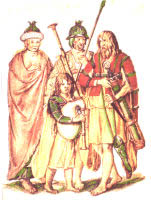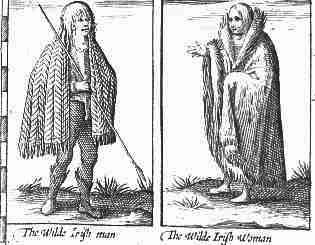
Irish woman with kern |

Wilde Irish |
Visitors to Ireland noted aspects of dress peculiar to the Irish. Both women and men wore the Irish mantle, a large shawl-type fringed garment which might also serve as a blanket at night. Women wore red petticoats until quite recently, especially in the west of Ireland. They were sometimes described as wearing rolls of linen on top of their heads. Other garments included linen shifts, sleeveless bodices and tight trousers called 'trews' for men.
| The bride was clad in a red frieze petticoat and waist coat with green tape about the skirts; on her head she wore a white hood of linen, for they do not wear the kercher until they are married, and she sat in a dark corner of the room with two or three other young women about her. Description of a wedding in Kildare, 1683 quoted in Edward McLysaght, Irish life in the seventeenth century, Dublin, 1969, p. 357. |
Some visitors to Ireland complained about the looseness of women's garments. Saffron, a yellow colour, was favoured by men and women and John Dunton in 1699 related how 'burnt yellow' hair was in fashion for girls in the west of Ireland:
| ... the women commonly on Saturday night or the night before they make their appearance at mass or any public meeting do wash [their hair] in a lee made with a stale wine and ashes and after in water to take away the smell; by which their locks are of a burnt yellow colour much in vogue among them. Quoted by Katherine Simms, 'Women in Norman Ireland' in Margaret MacCurtain & Donncha Ó'Corráin, Women in Irish society: the historical dimension, Dublin, 1978, p.21. |

Irish woman with kern |

Wilde Irish |
In rural areas, there must have been a spinning wheel in almost every cabin by the end of the eighteenth century. Women spun their own yarn in the home from local wool and flax.
| The types of wheel differed in different areas: in Connemara the spinner worked standing up, in the Blasket Islands she sat down. On a fine day the wheel was carried out of doors ... A man of the time records: 'Me mother would come in and she in the long black cloak with the hood. She would draw the wheel to her and that was the office for me and my sisters to start carding. She would be singing to the wheel'. L.M. Cullen, Six generations: life and work in Ireland from 1790, Cork, 1970, p.23. |
The yarn was brought to a weaver to be made into cloth. In some areas, men wove cloth at home on large looms, women on narrower 'bandle' looms. The finished cloth could be made up into garments at home by the women. Leather and the fur of local animals were useful also for strength and warmth.
The poor relied on cast-offs, perhaps donated by the better-off or purchased as second hand clothes at the local fair or from travelling dealers. Women did much mending, patching and remodelling. Many people had to go without shoes or stockings because they wore out so quickly.
| Very many of them in Ireland are so ragged that their nakedness is scarcely covered, yet are they in health and active. As to the want of shoes and stockings, I consider it as no evil, but a much more cleanly custom than the bestiality of stockings and feet that are washed no oftener than those of our own poor. Arthur Young, A tour in Ireland, 1776-8, reprinted Cambridge, 1925, p.187. |
Clothes may reveal - or conceal - several aspects of a person such as age, gender, personality, wealth, status, locality or loyalty. In some areas women used dress codes to denote their marital status. A woman might show she was married by how she covered her hair or tied it up. She might even reveal she had given birth by the way she wore her linen roll on her head.
The English authorities tried to make the Irish conform to their own customs and even included regulations about clothes in Irish laws from time to time. By the mid eighteenth century, Irish people, rich and poor, male and female, influenced by their wealthier neighbours, were drifting towards English fashions in dress. Their friends might be sarcastic but the Irish style of dress did give way eventually.